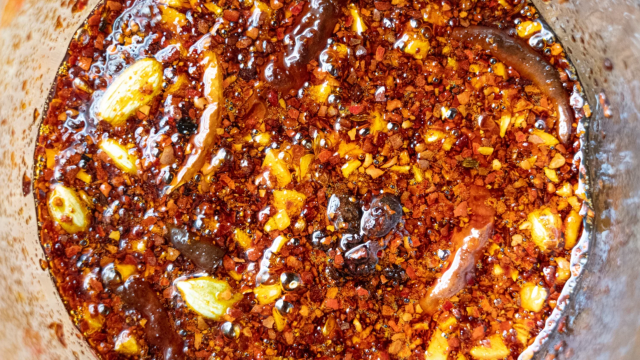Everyone loves a punchy, flavourful, shelf-stable pantry staple, but let’s be honest — we can’t survive on anchovies and tomato paste alone. Most of the bulk ingredients that we’ll rely on in the weeks and months of quarantining ahead need a lot of sprucing up, and in a world where shopping for fresh ingredients is potentially dangerous, this means getting creative with homemade condiments.
Chilli oil is here for you in these wild, unpredictable times. In its simplest form, it’s just cooking oil, garlic, salt, dried chilli flakes, and about five minutes of actual work. You’ll find the fruits of your hard labour are every bit as intense and transformative as chimichurri or basil pesto, but made entirely from shelf-stable ingredients. Once you’ve tasted your first batch, you’ll wonder why you ever bothered buying it — that is, if you can stop eating it long enough to think about your past mistakes. Here is everything you’ll need to make your own:
- A large (at least 4 cups) heatproof container
- 2 tablespoons-1/4 cup dried chilli flakes
- 2-4 cloves garlic, minced or thinly sliced
- 1/2 teaspoon of salt, or more to taste
- A pinch or two of MSG (optional)
- 2 tablespoons assorted whole dried spices (or more)
- 1 cup of neutral, high-heat cooking oil
If the quantities seem a little loosey-goosey, that’s kind of the point. Everything is negotiable besides the oil and chilli flakes, and even the ratio of those two key ingredients doesn’t really matter: If you crave tongue-numbing heat, use more chilli flakes; if you don’t, use less. As for the other flavourings, you can go as maximalist or as minimalist as you like. A kitchen sink’s worth of whole spices makes a fantastically complex condiment, but I think there’s also something to be said for the perfect simplicity of crushed red pepper flakes and garlic. Truly, there’s no right or wrong answer — follow your heart.
Start by putting your chilli flakes, garlic, salt, and optional MSG into a heatproof container. As you’ll soon see, the mixture bubbles up like crazy when you pour in the hot oil, so use the largest container you have. Here, I’ve got a heaping 1/4 cup of gochugaru (Korean red chilli flakes — fruity, relatively mild, and neon red), 4 small cloves of minced garlic, roughly 1/2 teaspoon of table salt, and a pinch of MSG in a 4-cup Pyrex measuring cup.
Be sure to set a trivet underneath the container to protect your table or countertop; you’re about to pour smoking hot oil in it, and that’ll leave a mark.
Next, gather your whole spices. I chose star anise, Sichuan peppercorns, green cardamom pods, some whole dried chilés de árbol for extra heat, cumin seeds, and a cinnamon stick for good measure. (Pro tip: snap cinnamon sticks in half to make storage easier.)
Toast everything in a dry skillet over medium heat for a minute or two until the spices start smoking, then add them to the measuring cup with the chilli flakes, garlic, and seasonings.
Heat the oil in a saucepan over medium heat until it, too, is lightly smoking. Very carefully pour the boiling hot oil over the spices and aromatics in the measuring cup and stir gently to combine.
Let cool completely and transfer to an airtight container for storage. It’ll get more flavourful the longer it sits, but you can start pouring your chilli oil on anything and everything the second it cools off. For food safety reasons, store it in the refrigerator. As the University of Idaho Extension program helpfully explains, raw garlic can be a source of Clostridium botulinum — aka, the botulism bacteria. These bacteria thrive in low-acid, low-oxygen environments, like a jar of chilli oil.
If there’s a bland food that isn’t improved by homemade chilli oil, I haven’t met it yet — even a bowl of plain white rice with plain steamed tofu is addictively delicious with enough drizzled on top. To be perfectly honest, I mostly use mine to jazz up scrambled eggs (for some reason, it’s extra right on cornstarch eggs), but today I dug some homemade dumplings out of the freezer and absolutely doused them with spicy, garlicky, electric orange gold. It was exactly what I needed, and it’s probably what you need too.
This story was originally published in March 2020. It was updated on March 3rd, 2021 to recommend refrigerated storage and to reflect Lifehacker’s current style guidelines.

Leave a Reply
You must be logged in to post a comment.